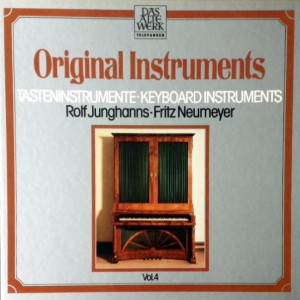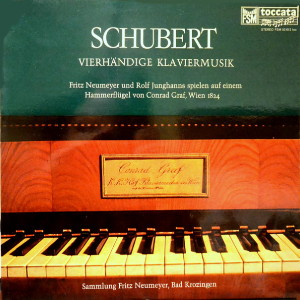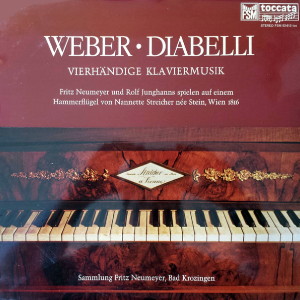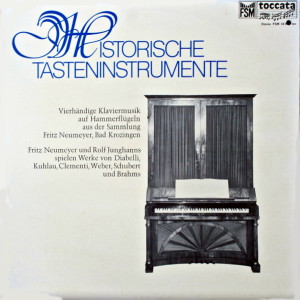 |
3 LP's
- Telefunken 6.35584 EK (c) 1981
|
 |
| 1 LP -
Toccata FSM 53 612 (p) 1975 |
 |
| 1 LP -
Toccata FSM 53 613 (p) 1975 |
 |
| 1 LP -
Toccata FSM 43 603 (p) 1976 |
|
| ORIGINALINSTRUMENTE -
Tasteninstrumente Vol. 4 |
|
|
|
|
|
|
|
|
Long Playing 1
|
|
|
|
| Franz Schubert (1797-1828) |
Grand
Rondeau A-dur, Op. 107; D 951
*
|
|
11' 33" |
A1 |
|
Andantino
varié h-moll, Op. 84 Nr. 1; D 823
* |
|
8' 45" |
A2 |
|
Fantaisie
f-moll, Op. 103; D 940 *
|
|
18' 08" |
B1 |
|
-
Allegro molto moderato · Largo · Allegro
vivace · Tempo I |
|
|
|
|
Long Playing 2 |
|
|
|
| Anton Diabelli (1781-1858) |
Sonate
D-dur, Op. 33 **
|
|
10' 22" |
C1 |
|
-
Allegro moderato |
3' 47" |
|
|
|
-
Andante cantabile |
2' 40" |
|
|
|
-
Rondo Allegretto |
3' 55" |
|
|
| Carl Maria von Weber
(1786-1826) |
Huit
pièces, Op. 60 **
|
|
32' 59" |
|
|
1.
Moderato |
2' 52" |
|
C2
|
|
2.
Allegro |
4' 17" |
|
"
|
|
3.
Adagio |
3' 55" |
|
"
|
|
4.
Allegro, tutto ben marcato |
4' 19" |
|
D1 |
|
5.
Alla Siciliana. Allegro |
3' 56" |
|
"
|
|
6.
Tema Variato. Andante |
3' 09" |
|
"
|
|
7.
Marcia. Maestoso |
5' 23" |
|
"
|
|
8.
Rondo. Scherzando vivace |
5' 08" |
|
"
|
|
Long Playing 3 |
|
|
|
| Anton Diabelli (1781-1858) |
Sonata
C-dur, Op. 37 *
|
|
12' 27" |
E1 |
|
-
Allegro moderato · Andante cantabile
· Rondo · Allegretto |
|
|
|
| Franz Schubert (1797-1828)
|
Grande
Marche es-moll, Op. 40 Nr. 5; D
819 **
|
|
10' 02" |
E2 |
| Johannes Brahms (1833-1897) |
Zwei
Walzer, Op. 39 Nr. 15 und 16
***
|
|
3' 32" |
E3 |
| Friedrich Kuhlau (1786-1832)
|
Sonate
G-dur ****
|
|
8' 20" |
F1 |
|
-
Allegro · Arioso · Rondo · Allegro
|
|
|
|
| Carl Maria von Weber
(1786-1826) |
Andante
con Variazioni, Op. 10 Nr. 3
***** |
|
5' 35" |
F2 |
| Muzio Clementi
(1752-1832) |
Sonate
Es-dur ******
|
|
8' 50" |
F2 |
|
-
Allegro maestoso · Andante · Tempo
di Menuetto |
|
|
|
|
|
|
|
|
Fritz
NEUMEYER & Rolf
JUNGHANNS,
Vierhändige Klaviermusik
|
|
|
|
|
|
|
(Long Playing 1)
|
(Long Playing 2)
|
(Long Playing 3) |
| -
Hammerflügel von Conrad
Graf, Wien 1824 *
|
-
Hammerflügel
von Nannette
Streicher,
Wien 1816
**
|
-
Hammerflügel
von Michael Rosenberger,
Wien 1810 (restauriert
von Rudolf Dobernecker)
* |
|
|
-
Hammerflügel von Conrad Graf, Wien
1824 (restauriert von Martin
Scholz) ** |
|
|
-
Hammerflügel von J. B. Streicher
u. Sohn, Wien 1864 (restauriert
von Hugo Haid) ***
|
|
|
-
Schrankflügel, unsigniert,
süddeutsch um 1820 (restauriert
von Rudolf Dobernecker) ****
|
|
|
-
Tafelklavier von Joseph Bogner,
Freiburg/Br. um 1840 (restauriert
von Rudolf Dobernecker) *****
|
|
|
-
Hammerflügel von John Broadwood
and Sons, London 1817 (restauriert
von Kurt Wittmayer) ******
|
|
|
|
|
Luogo
e data di registrazione |
|
Schlos
Bad Krozingen (Germania) - 1975
(long playing 1 & 2)
/ 1976 (long playing 3)
|
|
|
Registrazione:
live / studio |
|
studio |
|
|
Recording
Supervision
|
|
Paul
Dery |
|
|
Edizione LP |
|
TELEFUNKEN
- 6.35584 EK - (3 LP's - durata
38' 26", 43' 21" & 48' 46") -
(p) 1975/76 - (c) 1981
|
|
|
Originale LP
|
|
TOCCATA
- FSM 53 612 - (1 LP - durata
38' 26") - (p) 1975 -
Analogico (long playing 1)
TOCCATA - FSM 53 613 - (1 LP -
durata 43' 21") - (p) 1975 -
Analogico (long playing 2)
TOCCATA - FSM 43 603 - (1 LP -
durata 48' 46") - (p) 1976 -
Analogico (long playing 3)
|
|
|
Prima Edizione CD |
|
-
|
|
|
Note |
|
Production
by Toccata.
|
|
|
|
|
Long
Playing
1
The
Fantaisie in f
minor and the
Grand Rondeau in A
major are the two
great pieces for
piano for four
hands, which Franz
Schubert wrote in
1828, the year of
his death. They
are highlights in
the rich and,
until the
beginning of our
century, much
loved genre of
four hands piano
music. The proud
rhythms of the
Hungarian
folkmusic and a
melancholic Puszta
atmosphere
alternate with
sweet and blissful
Viennese melodies
and alpine country
triad motives.
Added to this was
the inclination of
the late Schubert
towards the
perfection of form
by use of
counterpoint.
These elements are
changed in the
Grand Rondeau into
an idyllic and in
the Fantaisie into
a tragic form and
prevade the
Andantino varie as
well.
All these pieces
originate from the
romantic spirit of
the 19th century
in the sense of E.
Th. A. Hoffmann’s
saying: music
opens to man a
"secret realm of
spirit"; and as
stated in
Schubert’s song
"An die Musik" it
takes man away
into a "better
world". Schubert
reaches this aim
of the romantic
musician in an
ingenious way
through his
harmony, which is
enlarged through
new tonal
connexions in an
unimagined manner.
The experience of
a romantic magic
of sound reaches
its height when
the piano music,
written by
Schubert, is
played on an
instrument that
corresponds to the
ideal of the
composer: the
pianoforte
(Hammerflügel) by
Conrad Graf. This
masterpiece of
Viennese
piano-building has
a transparence of
overtone and the
easy sensitive
touch of the
classical Viennese
pianoforte. It
possesses,
however, a
cantabile
abundance and an
unique variability
of timbre, which
is produced
through the style
of registration
and the use of the
so-called
"changements" (see
below).
We can conclude
from the specially
subtle dynamic
instructions that
Schubert composed
for such an
instrument as he
asks for
differenciated
shades up to a
threefold
pianissimo with
diminuendo.
Our instrument
with its pure
wooden
construction, the
leather covered
hammers and the
thin strings was
built by Conrad
Graf in the year
1824. The four
pedals change the
sound in the
following manner:
1. Removal of the
damper.
2. Pianoregister:
a piece of cloth
is slide between
hammers and
strings and this
produces a soft
and delicate tone.
3.
Bassoonregister: a
parchment scroll
is pressed upon
the bass strings
and this produces
a buzzing sound.
4. Displacement of
the keys: For
every tone exist
three strings.
When the keys are
displaced only two
or one string is
touched.
The instrument was
restored by Martin
Scholz, Basel, and
Rudolf
Dobernecker,
Freiburg im
Breisgau.
Long
Playing 2
On April
16th 1813, Carl
Maria Weber wrote
to his brother
from Vienna: "I
have just bought
two superb
instruments, a
Streicher and a
Brodmann. In a
single day I must
have seen a good
fifty different
pianos, and not
one of them could
hold a candle to
these two."
The piano built by
Nannette Streicher
née Stein which is
played on this
recording is a
sister instrument
to the one Weber
bought. Nannette
Streicher was the
daughter of the
Augsburg organ-
and piano-builder
Johann André Stein
(1728-1792), the
most famous
craftsman of his
time, who was also
highly esteemed by
Mozart. Nannette,
who was born in
1769, was already
being acclaimed as
a child prodigy
for her
piano-playing at
the age of eight.
However, Mozart
judged her rather
critically on his
visit to Augsburg
in 1777: "She has
the ability to be
a great musician,
she has genius,
but she won’t
achieve anything
in this way." She
did not, however,
become a piano
virtuoso, but
learnt the craft
of piano-building
from her father,
taking over the
workshop after his
death. In 1794 she
married Andreas
Streicher, a
boyhood friend of
Schiller’s. (It
was Streicher who
helped Schiller to
flee from
Stuttgart, where
he had been
forbidden to write
literature outside
the scope of his
work as an army
doctor, to
Mannheim in 1782.)
The piano workshop
was moved to
Vienna, the centre
of contemporary
musical life, and
the firm soon
gained fame
throughout Europe
under the name
"Nannette
Streicher née
Stein a Vienne".
Alongside Weber
and Beethoven (a
personal friend
and protégé of
Nannette’s),
E.Th.A. Hoffmann,
Zelter, Reichardt
and many others
were clients of
the firm, and
prized its
instruments
greatly. Thus the
Streicher salon
became a
rendezvous for the
music-lovers of
Vienna.
The piano pieces
for four hands by
the successful
composer and music
publisher Anton
Diabelli are noble
music for just
such a refined
audience: salon
music which avoids
descending into
shallowness and
superficiality.
The orchestral
fullness and
diversity of
timbres that
characterize
Streicher
instruments may
have offered
particular
inspiration to the
master of the
Romantic
orchestra, Carl
Maria von Weber.
His Huit
Piéces op. 60
combine
superlative
compositional
technique with
allusive poetic
content: they can
be regarded as
scenes from
Weber’s operas
transferred into
the purely
instrumental
medium.
1) The moderato
can be
understood as a
forest scene
which combines
the idyllic and
the sinister.
2) The allegro,
with its noble
march rhythms,
recalls the
knight Huon of
Bordeaux from
the composer’s Oberon.
3) Oberon
himself, King of
the Elves, leads
his retinue to
the dance.
4) Years
before Schubert
wrote his piano
pieces for four
hands, inspired
by Hungarian
folk music,
Weber composed
this allegro,
so full of the
proud,
melancholy
sounds of the
steppes.
5) The
rocking rhythm
of the siciliana
recalls the song
of the mermaids
from Weber’s
opera Oberon.
6) The
theme of the
brilliant and
witty variations
is a popular
song of Weber’s
own invention.
7) The
demonic march is
a reflection of
history: foreign
troops marching
through Vienna,
capital of the
then
Austro-Hungarian
Empire. In the
trio an image of
freedom seems to
hover before us.
8) The rondo
is an early
waltz, in which,
as in nearly all
of Weber’s
compositions,
the sinister and
the demonic are
evident.
The
Streicher piano’s
richness of timbre
results from the
so-called
"transformations",
which are employed
in a similar way
to the registers
of an organ or
harpsichord, and
are achieved by
the use of four
pedals:
l)
Suspension of
the damping:
only employed as
a special
effect, so that
the strings
sound noisily
confused.
2) Piano
register: a
strip of cloth
is inserted
between the
leather-covered
hammer and the
strings, giving
a soft and
suppressed tone.
3)
Bassoon
register: a roll
of parchment is
pressed against
the strings in
the bass,
producing a
droning sound
similar to that
of the old
bassoon.
4)
Displacement:
the keyboard and
the piano action
are shifted so
far to the
right, that not
all three
strings
available for
each sound are
struck, as is
usual, but only
two, or even one
(una corda).
The piano tone
becomes more
delicate and
transparent as a
result.
Long
Playing 3
The term
"Hammerklavier"
originally meant
the same as
"pianoforte" or
"fortepiano", and
was used by
Beethoven as a
Germanicization of
the latter names,
foreign to the
German language.
Nowadays,
"Hammerklavier"
covers the range
of pianotypes
current from
roughly the time
of Mozart to that
of Brahms, which
were predecessors
of our modern
piano, but not the
20th century piano
itself, although
this is, strictly
speaking, a
Hammerklavier too.
The early piano
types from the
time of Mozart
still resemble the
harpsichord in
construction and
in the sound
produced.They were
also referred to
as "cembalo col
piano e forte",
and subsequently
as "pianoforte".
The instrument’s
development
continued by way
of many
intermediate
stages: in an
effort to attain a
greater volume of
sound, pianos were
gradually built
with thicker
strings, larger
hammers and a
stronger
soundboard. All
this in turn
required a more
solid
construction: the
light box-like
harpsichord design
began to be
replaced by a
wooden frame,
which was
initially light,
but became
increasingly
sturdy.
Eventually, iron
stays were
necessary to
reinforce the
frame; iron plates
were then added,
and around 1860
the last step was
taken - a full
iron frame.
Likewise, the
mechanics of the
piano became
increasingly heavy
and more complex,
the last
development being
the introduction
of the double
repeating action
by Sebastian Erard
in 1823. It was
now possible to
play much faster
and louder, a
development which
corresponded to
growing virtuosity
in the medium.
Equally, the
change in the tone
sought after by
musicians - a
change which
occurred with
other instruments
at the time -
meant that certain
individual sounds,
like combined
harmonics and a
clear, sentimental
sound, were
abandoned in
favour of a more
robust sound which
was rather less
transparent.
The development of
the instrument
from the
harpsichord-like
fortepiano to the
armour-plated
grand piano only
took about eighty
years, and it was
in this period
that most of the
piano music played
today was written.
Mozart, Haydn,
Beethoven,
Schubert, Schumann
and even Brahms
owned instruments
which were
noticeably
different from our
modern piano. They
composed for these
pianos, and, in
their piano
writing, took into
account the tonal
characteristics of
their particular
instrument. The
first half of the
19th century was a
period of rapid
change for piano
building and piano
music alike.
This fact is most
clearly
demonstrated by
the instruments
built in Vienna,
the contemporary
centre of the
piano-building
industry: Viennese
pianos are,
without exception,
distinguished by a
sensitive,
delicate action.
The grand piano
built by Michael
Rosenberger of
Vienna in 1810
still has the
lightness and
transparency of
the Mozartean
instrument, but it
already produces a
more powerful
sound, and great
alterations to the
tone can be
achieved by the
use of no less
than six different
pedals. Among the
tone changes
possible are the
distinctive burr
of the bassoon
register (a
parchment roll is
placed against the
strings in the
bass) and the
so-called
janizzary
register, produced
by a large drum
and chimes built
into the piano.
The latter, also
called "Turkish
music", brings
exotic colouring
into the
sauntering rondo
of the
entertaining
sonata by
Diabelli, who was
a successful music
publisher as well
as a composer.
The Conrad Graf
grand piano was
only built some
fifteen years
later, but it is
quite differently
constructed: it is
heavier than the
Rosenberger
instrument, and
the sound has more
of the cantabile
about it; it is
more romantic and
somehow bulkier,
yet it remains
able to
differentiate
notes right down
to a
clavichord-like
pianissimo. Graf’s
instruments were
highly esteemed by
Schubert, whose
exact dynamic
specifications in
his scores,
extending to ppp,
certainly demand
the polychromatic
registers of the
Graf piano.
Schubert’s
mournful E-flat
minor march is
influenced by the
main theme of the
composer’s
"Wanderer"
fantasy.
A sister
instrument to our
Johann Baptist
Streicher piano
dating from 1864
stood in Brahm’s
appartment in
Vienna. It is
still without an
iron frame, and
still has the
"Viennese action",
as opposed to
Erard’s double
repeating action,
and
leather-covered
felt hammers.
Brahm’s waltzes
for four hands
show felicitously
how the phlegmatic
Hamburger made
himself at home in
the Vienna
ambience.
The upright piano
was derived from
the Hammerklavier,
and was built in a
variety of forms
in the 19th
century: there was
the lyre-piano,
the giraffe-,
pyramid- and
cabinet-pianos.
All four models
functioned not
only as musical
instruments, but
as decorative
furniture in the
Biedermeier
period. And it was
genuine
"Biedermeier
music" that came
from the pen of
Friedrich Kuhlau,
a native of Uelzen
in Lower Saxony.
Kuhlau, later
Kapellmeister at
the Danish royal
court, wrote a
touching
pot-pourri that
reflects this
ornamental but
superficial
period: the
fairy-tale world
of Hans Christian
Andersen mixed
with the colourful
bustle of the
Tivoli Gardens.
In terms of sound,
there is scarcely
any difference
between the
upright and the
grand pianos built
at the time. The
smaller baby grand
as we know it
today was a later
phenomenon. Its
predecessor was
the square piano,
an instrument
which derived its
external
appearance from
the clavichord -
in fact, it looks
like a clavichord
without legs. More
modest in sound
than the full-size
grand pianos, the
square piano is
ideal for playing
small-scale,
unpretentious
pieces like
Weber’s attractive
Andante con
Variazioni.
The great rivals
of Vienna built
instruments since
the 17th century
had been English
pianos: these were
from the outset
equipped with a
less sensitive,
more robust
action, which made
richer-sounding
playing possible,
and in the end
they completely
supplanted the
Viennese pianos on
account of their
more ample sound.
The Broadwood
piano played here
is the same model
as the instrument
which the London
piano-builder
Broadwood sent
Beethoven as a
gift in 1817: for
a while the piano
afforded renewed
pleasure to the
composer, who was
steadily going
deaf. The Italian
composer Clementi,
whom Beethoven
highly respected,
was also the
joint-owner of a
piano factory, and
built similar
instruments.
|
|
|

